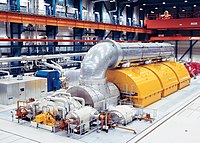
Photo from wikipedia
This paper provides a review of different contributions dedicated thus far to entropy generation analysis (EGA) in turbulent combustion systems. We account for various parametric studies that include wall boundedness,… Click to show full abstract
This paper provides a review of different contributions dedicated thus far to entropy generation analysis (EGA) in turbulent combustion systems. We account for various parametric studies that include wall boundedness, flow operating conditions, combustion regimes, fuels/alternative fuels and application geometries. Special attention is paid to experimental and numerical modeling works along with selected applications. First, the difficulties of performing comprehensive experiments that may support the understanding of entropy generation phenomena are outlined. Together with practical applications, the lumped approach to calculate the total entropy generation rate is presented. Apart from direct numerical simulation, numerical modeling approaches are described within the continuum formulation in the framework of non-equilibrium thermodynamics. Considering the entropy transport equations in both Reynolds-averaged Navier–Stokes and large eddy simulation modeling, different modeling degrees of the entropy production terms are presented and discussed. Finally, exemplary investigations and validation cases going from generic or/and canonical configurations to practical configurations, such as internal combustion engines, gas turbines and power plants, are reported. Thereby, the areas for future research in the development of EGA for enabling efficient combustion systems are highlighted. Since EGA is known as a promising tool for optimization of combustion systems, this aspect is highlighted in this work.
Journal Title: Entropy
Year Published: 2022
Link to full text (if available)
Share on Social Media: Sign Up to like & get
recommendations!